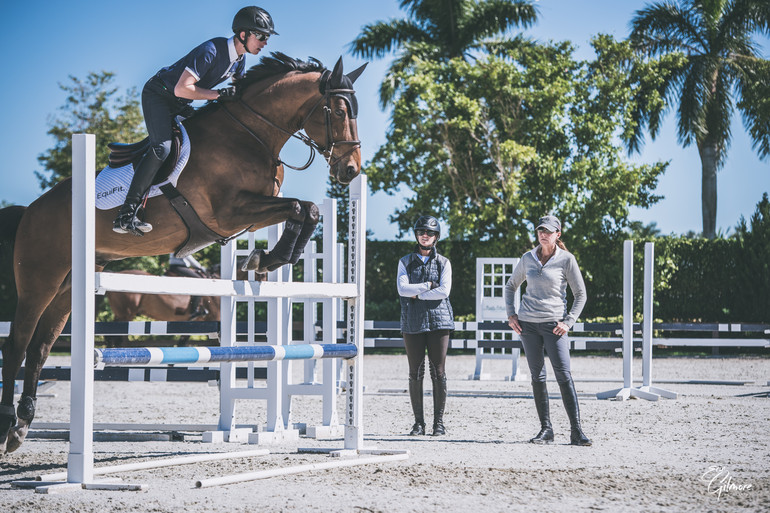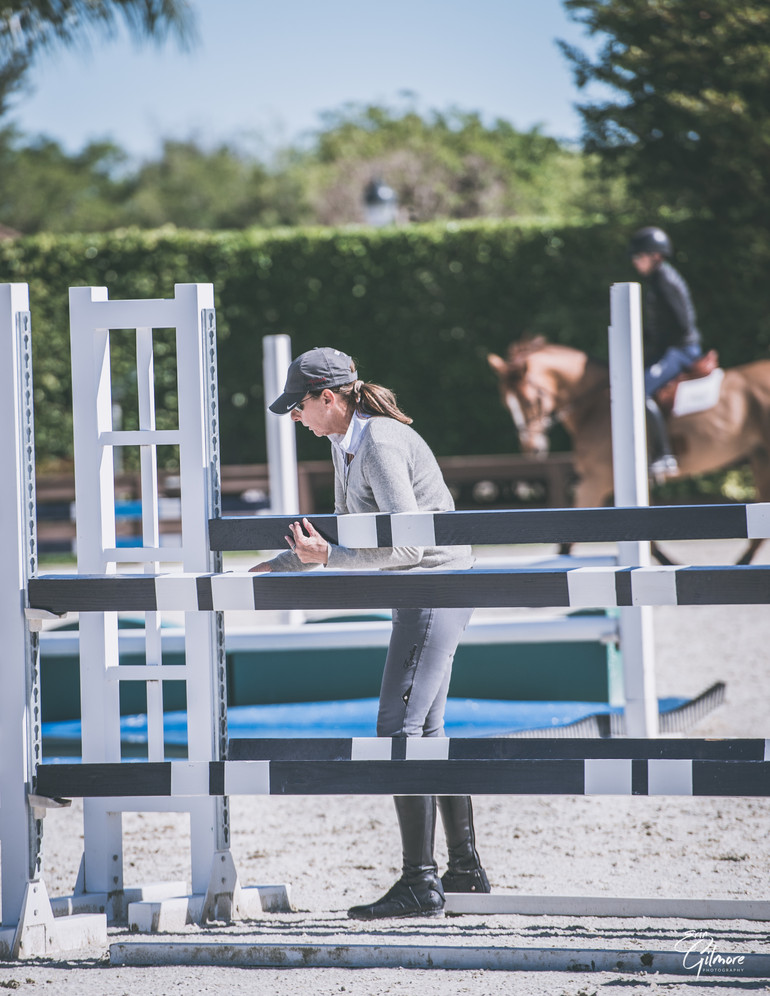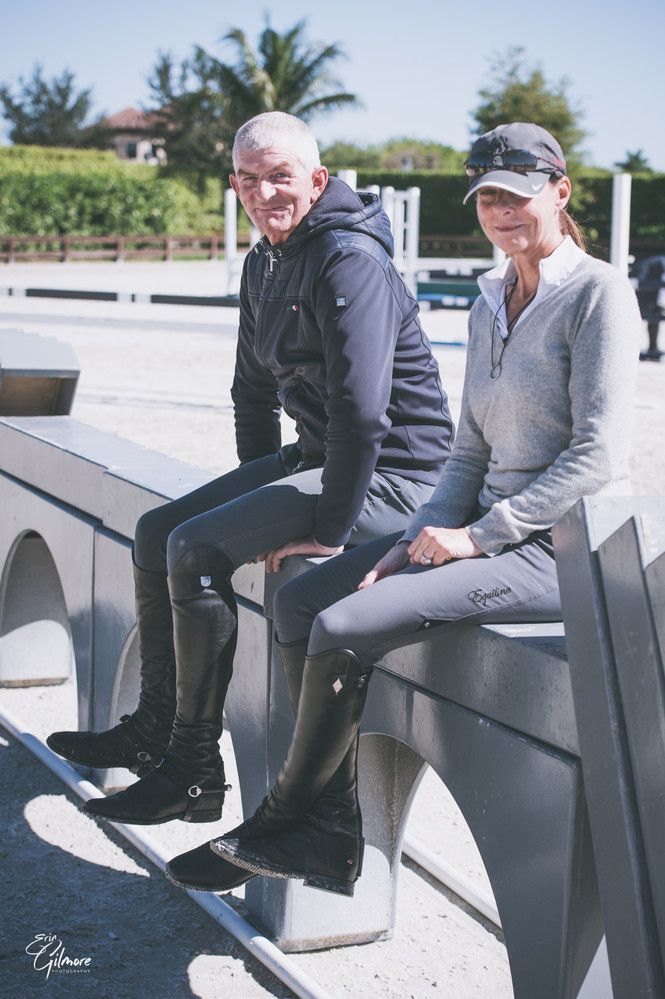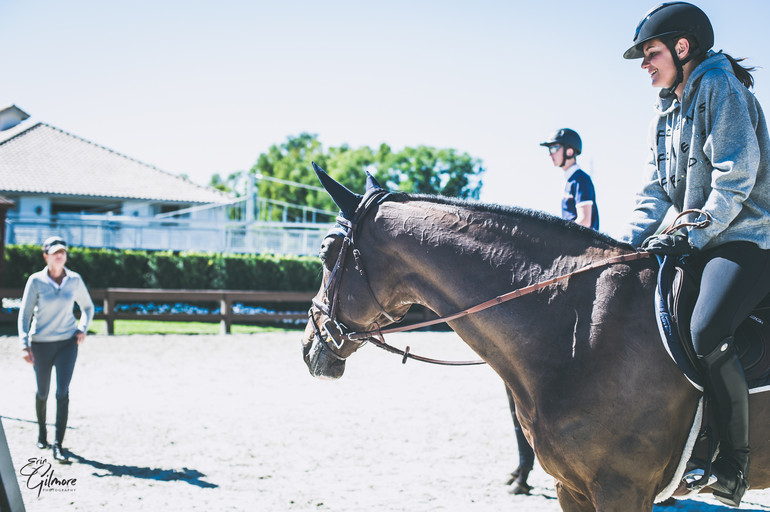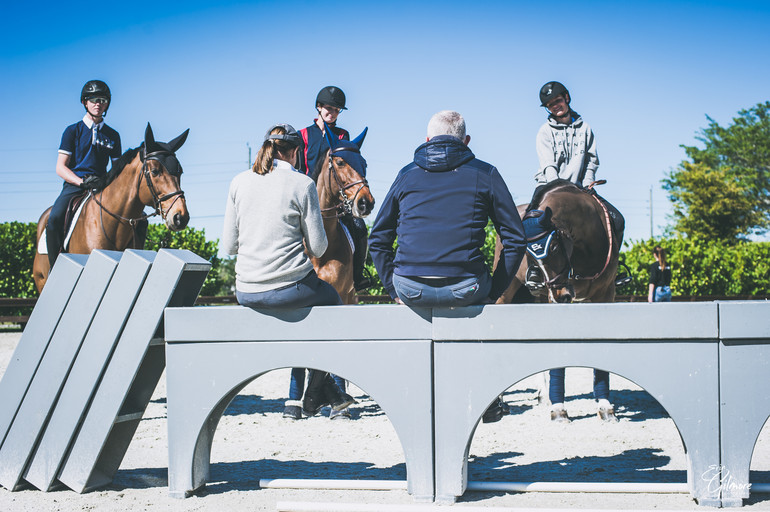Missy Clark knows how to create a top rider. Big names coming out of her program at North Run include Darragh Kenny, Julie Welles, Michael Hughes, Catherine Tyree, Erynn Ballard, Hardin Towell, as well as Hillary Dobbs – who became one of the youngest riders in US showjumping history to win $1,000,000 in Grand Prix prize money. For the last twenty-five years, Missy has guided several North Run riders to win a national equitation championship. Last year, North Run working student Sam Walker impressed again and again, winning the ASPCA Maclay National Championship in Kentucky, the CET Medal National Final in Toronto and he recently topped the George Morris Equitation Championship at the Winter Equestrian Festival in Wellington. “I have had a long list of riders at North Run who have gone on into the business, and it’s one of the things I am really proud of,” Missy says.
The importance of correct flatwork is at the very core of Missy’s system. “One of the most important things we try to teach at North Run is correct flatwork. Things like how to put a horse in front of your leg, on the bridle, and getting the horse to go forward and come back are important components in today’s world. Rideability is such a key factor. Of course, the best riders can handle horses when they are a bit difficult, but most can’t. For most people to have any version of success the horses have to be so well schooled,” Missy says.
Missy’s early influence came from her mother, Doris Hall Clark. “She was a pretty well-rounded horse woman,” Missy smiles. “She used to work in a professional stable in Toronto, and back in her day they did jumpers, hunters, gaited horses, drove the hackney ponies, rode side-saddle – they did everything, it was amazing really. My mother taught all her children to ride, but I was the only one who really took to it. We had a very close relationship.”
“As a junior I started riding for a well-known professional, Chuck Graham, who asked me to be his working student and ride all of his horses,” Missy tells. “Additionally, I rode in some clinics with George Morris who I formed a life-long friendship with. From having a teacher-student relationship, as time went on we developed into really good friends. I adore George, and I have to stress the influence he has had on me. Everything I do, as well as my philosophies in riding, are a direct result of George.”
“I think one of the most important things George taught me is to be very concise in my teaching. His system cuts to the point, it’s very direct and it’s all based on correct flatwork and horsemanship,” Missy tells. “That just resonated with me and made sense.”
“Darragh Kenny who worked for North Run for several years embraced my interpretation of George Morris’ system as well as anyone. I remember a few years ago in Chantilly watching Darragh flatting one of his horses. I thought to myself ‘I love what he is doing’. He got the memo!” Missy laughs. “Darragh always had natural ability. When he first started with us, I often had him school some of the horses over some of our crazy equitation courses! I think it served him well. The US equitation system’s influence on Darragh has enabled him to ride line and track as well as anyone in the world, like for example Mclain Ward who came through that system.”
“My theory is: If you notice it, it’s wrong!” Missy laughs. “In the US rule book for the equitation division, they use the wording ‘invisible aids’, and that is a good way to describe what correct riding should look like. Position flaws are some of the biggest mistakes I see. That’s when you insert the emoji with the monkey covering his eyes, and I do that a lot in my own mind!”
Next to solid basics in riding, Missy believes that her most successful students have a few more things in common as well. “People who continue on with success usually have such a genuine love for the horses and the sport,” she says. “They have the common denominator of work ethic and perseverance, and the ability to pick themselves up and keep going when things do not go well. Because God knows there are more days that don’t then do! There are only a few who are born with natural talent, so the rest of the world has to work at it. These people become proficient because they have a great work ethic. Both ways work, and that’s the beauty of it!” Missy smiles.
North Run started as a branch growing out of Missy’s mother’s Fox Run Ltd. “My mother and I started a business from our backyard at our small farm outside of Buffalo, New York – I was 18-19 at the time,” Missy recalls of the early days as a trainer. “I kept inching along with some local students back then. The first one who went on to anything truly noteworthy was Sheila Burke. She was my first student to get a ribbon in an equitation final, she was my first rider to ride for the US Equestrian Team, and she went on to win the Dublin Grand Prix. She was my first student to break through, and we continued from there.”
In April 2003, Missy married John Brennan (the couple got married in Las Vegas during the World Cup Final, at the same drive through chapel where Britney Spears infamously tied the knot in 2004 – “but that’s off the record!” Missy laughs). “John has been such a great addition to North Run,” Missy says about her Irish husband and better half. “He is such a hard worker and he loves the sport. He lives it all day, every day, and he is a great problem-solver!”
Missy and John have a farm in Vermont which is the current summer base for the North Run team. “We love that place! It’s on top of a mountain, and we overlook the ski slopes at Sugarbush. It’s therapeutic to be there!” Missy smiles. “It’s 99 acres, and we have 62 boxes, as well as a big indoor and outdoor ring. I never walk into our indoor ring without thinking ‘wow!’ When I grew up we had a teeny-weeny indoor. You were lucky if you could do four strides down the longest side! Back in the days when I had all the equitation kids getting ready for the finals, there was no room to set up a proper course. There was a big door at one end of the indoor which led to the outside, so I put a fence there and made my students jump out of the indoor ring. From there they continued to our outdoor ring where more jumps were set to finish their course. I had to improvise!” Missy laughs.
For the last three years, Missy, John and their team have based out of North Run South, located in Grand Prix Village in Wellington, for the winter. “It’s so nice! A) because the circuit here is so long, and B) it’s hard work, so it’s great to be able to escape from the showgrounds in between. We come down right after the Kentucky National Horse Show in early November and stay until early May before heading north to Vermont.”
This year’s Winter Equestrian Festival has been particularly busy for Missy and John, with riders at all levels showing throughout the twelve weeks of competition. “We’ve had Cat Tyree, Tomi Yofre, Emily and Zoe Conter and Becky Conway for the FEI classes. We also had our U25 squad and riders in junior divisions. All in all, we had 91 horses for our students here,” Missy says. “Most of our students are in and out since they also go to school. Many come in for the weekends to have lessons and to show. We handle the riding and the training in between. John and I have amazing assistants who help us with the riding and wonderful grooms to care for the horses. Without all of them, none of what we accomplish would be possible.”
Next to her exceptional skills as a trainer, Missy is well known for her ability to match the perfect horse-and-rider combination. “When selecting a horse, it of course depends on the level of the rider. For beginner riders, you would like more of a veteran – a horse that has a lot of mileage, that is very forgiving and not super careful. Those types of horses will allow the riders to focus on themselves,” Missy says. “Then as the rider becomes more proficient, you can notch up the components of the careful-factor. As the riders get a bit older with more experience, you can also look for a young horse to develop, like Cat Tyree has done now with Lorenzo. Knowing your type of horse is also important, and the more I know my riders the more I know their type. I have one rider who is so much better on a bigger, super-scopey kind of horse and I have another who is more comfortable on a smaller type with more blood. You have to know where the comfort zone is for each rider. Nobody knows their type straight away, so a lot of times people are going to make a mistake – I don’t care who you are, it’s going to happen!” Missy laughs. “I think that the most common mistake people make when buying a horse for a greener rider is getting one that is A) too young, or B) too careful,” Missy continues. “Top riders, however, would say the more careful the better!”
With decades of experience, Missy has witnessed a lot of changes in the sport and in the riders too. “One thing I’ve noticed is that a lot of kids decide to become professionals in today’s world. However, many of them don’t step back to start where we did. Many want to start at the five-star Grand Prix level. Most of the older generation did not start their careers this way. They showed at plenty of local level shows and went on from there,” Missy says.
“As an example, Cat Tyree has been with us for the past eight years since she was a junior rider. As of this winter in Florida, she began working for us. She is here all day, every day, putting in a full day of work. She often rides seven to twelve horses a day, and spends a lot of time on her own horses. When we come back here at the end of the day, Cat is always here to do the list for the next day. Her hard work reflects in her results. Cat also loves the sport, she studies it, she knows it and that comes across in her attitude. Anyone who competes has to realize you are going to have good days and bad days in this sport. It’s the same for everyone, but the people who keep working every day and persevere are the ones who succeed,” Missy says.
On her motivation as a trainer, Missy is clear. “I think the American system is a great one because many of our riders come through our US equitation division. Participating in this division allows riders to pursue the basics in a structured setting. For me equitation is a means to create the best rider you can create, even if they win the finals or they don’t. If you look at most of our top riders, they came through our system, like Mclain and Beezie did. These junior years are when you can learn about your position, flatwork, line-and-track, and all the details that are really beneficial to your riding.”
“The equitation years are when you need the right animal for the job,” Missy continues. “The horse needs to handle the load of repetitive work and lessons. You have to have a special horse for that job. Finding a top level equitation horse is as hard as finding the best Grand Prix horse. Equitation horses have to be good jumpers, have a very good balance, and a wonderful disposition to not get annoyed when you are repeating the pattern over and over. They have to be beyond brave and fearless to jump many of the jumps that are presented in their classes. Additionally, they need to be sound to deal with all of that! So they are hard to find,” she laughs.
“In Europe, things are different. Most kids have a lot of guts. You can see this when watching the little kids flying around on pony jumpers at the Dublin Horse Show. In the US, most young kids start their show career on hunter ponies where things happen over lower fences at a much slower pace. The kids in Europe are gutsy and brave which is an important factor in their development as riders.”
“I think the US has had influence on the European style and vice-versa,” Missy continues. “I think the world has adapted to more of a jumping seat. If you look at Marcus Ehning, he could be an American rider style-wise. That kind of riding is just so much more efficient.”
If there is one piece of advice Missy would give any rider, what would it be? “Get yourself in a program that works for you and stick with it. Be a student of the sport, read – people don’t read anymore. Don’t be in a rush, the slow way is the best way in this sport. And never give up. Even when you are lying on the ground looking up at them – don’t give up,” she laughs.
Text © World of Showjumping
Photos © Erin Gilmore
No reproduction without permission, copyright © World of Showjumping



